Enterprise Leadership 700252: Contingency Theory of Management
VerifiedAdded on 2022/09/14
|7
|1833
|28
Essay
AI Summary
This essay provides a comprehensive analysis of the contingency theory of management, contrasting it with earlier management theories. It begins by defining the contingency approach, emphasizing its dependence on situational variables and its impact on organizational success. The essay then explores various contingency theories, including the Situational Leadership Model by Hersey and Blanchard, Fiedler’s Contingency Leadership theory, Tannenbaum and Schmidt's leadership continuum theory, Path-goal leadership theory by Robert House, and the Normative leadership theory. It highlights the core principles, strengths, and limitations of each theory, underscoring the importance of adapting leadership styles to specific contexts. The essay concludes by summarizing the advantages and disadvantages of contingency theories, emphasizing the complexity involved in their application and the need for flexibility in leadership to achieve optimal results. Overall, the essay demonstrates how the contingency theory evolved to address the limitations of earlier leadership models, offering a more nuanced and effective approach to organizational management.
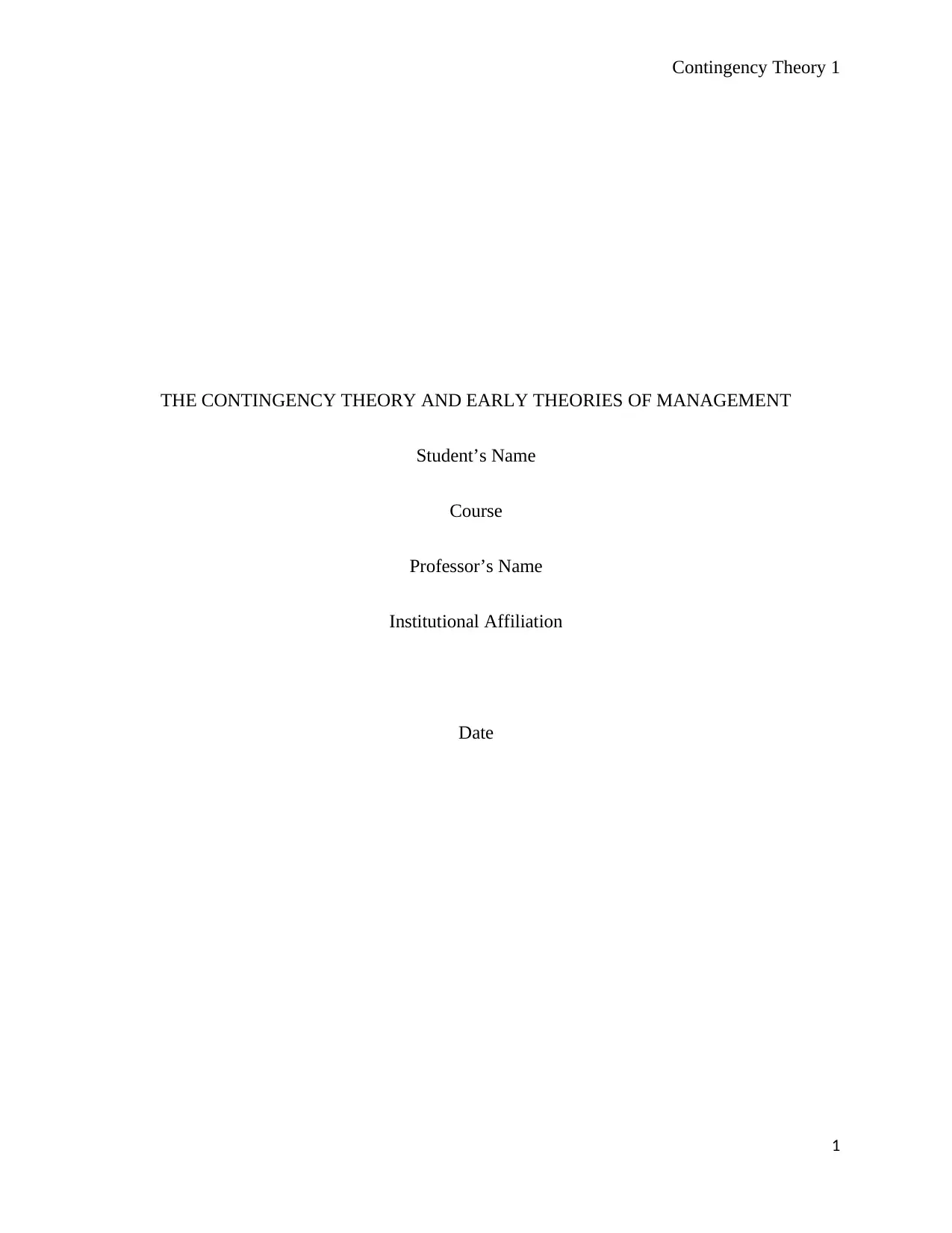
Contingency Theory 1
THE CONTINGENCY THEORY AND EARLY THEORIES OF MANAGEMENT
Student’s Name
Course
Professor’s Name
Institutional Affiliation
Date
1
THE CONTINGENCY THEORY AND EARLY THEORIES OF MANAGEMENT
Student’s Name
Course
Professor’s Name
Institutional Affiliation
Date
1
Paraphrase This Document
Need a fresh take? Get an instant paraphrase of this document with our AI Paraphraser
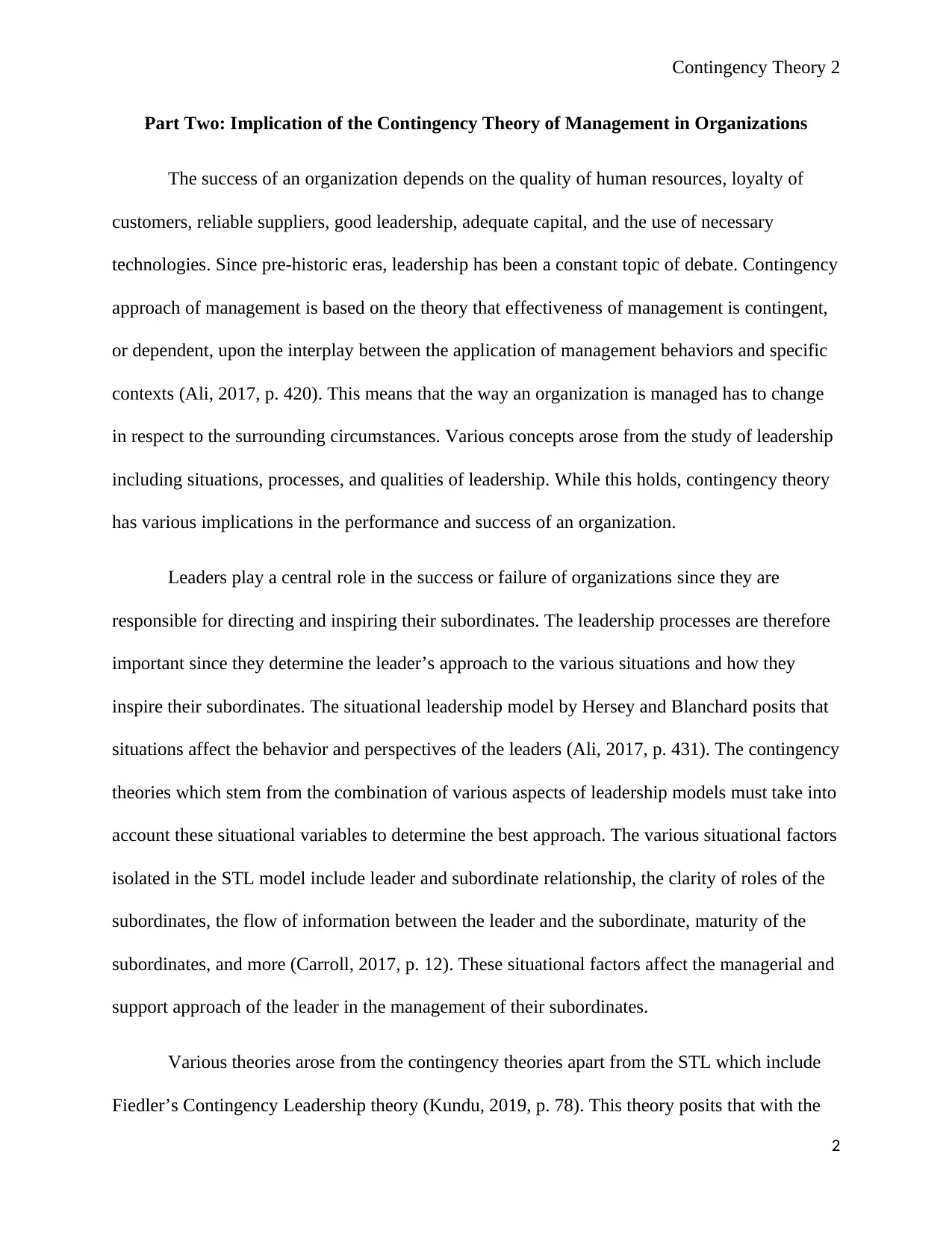
Contingency Theory 2
Part Two: Implication of the Contingency Theory of Management in Organizations
The success of an organization depends on the quality of human resources, loyalty of
customers, reliable suppliers, good leadership, adequate capital, and the use of necessary
technologies. Since pre-historic eras, leadership has been a constant topic of debate. Contingency
approach of management is based on the theory that effectiveness of management is contingent,
or dependent, upon the interplay between the application of management behaviors and specific
contexts (Ali, 2017, p. 420). This means that the way an organization is managed has to change
in respect to the surrounding circumstances. Various concepts arose from the study of leadership
including situations, processes, and qualities of leadership. While this holds, contingency theory
has various implications in the performance and success of an organization.
Leaders play a central role in the success or failure of organizations since they are
responsible for directing and inspiring their subordinates. The leadership processes are therefore
important since they determine the leader’s approach to the various situations and how they
inspire their subordinates. The situational leadership model by Hersey and Blanchard posits that
situations affect the behavior and perspectives of the leaders (Ali, 2017, p. 431). The contingency
theories which stem from the combination of various aspects of leadership models must take into
account these situational variables to determine the best approach. The various situational factors
isolated in the STL model include leader and subordinate relationship, the clarity of roles of the
subordinates, the flow of information between the leader and the subordinate, maturity of the
subordinates, and more (Carroll, 2017, p. 12). These situational factors affect the managerial and
support approach of the leader in the management of their subordinates.
Various theories arose from the contingency theories apart from the STL which include
Fiedler’s Contingency Leadership theory (Kundu, 2019, p. 78). This theory posits that with the
2
Part Two: Implication of the Contingency Theory of Management in Organizations
The success of an organization depends on the quality of human resources, loyalty of
customers, reliable suppliers, good leadership, adequate capital, and the use of necessary
technologies. Since pre-historic eras, leadership has been a constant topic of debate. Contingency
approach of management is based on the theory that effectiveness of management is contingent,
or dependent, upon the interplay between the application of management behaviors and specific
contexts (Ali, 2017, p. 420). This means that the way an organization is managed has to change
in respect to the surrounding circumstances. Various concepts arose from the study of leadership
including situations, processes, and qualities of leadership. While this holds, contingency theory
has various implications in the performance and success of an organization.
Leaders play a central role in the success or failure of organizations since they are
responsible for directing and inspiring their subordinates. The leadership processes are therefore
important since they determine the leader’s approach to the various situations and how they
inspire their subordinates. The situational leadership model by Hersey and Blanchard posits that
situations affect the behavior and perspectives of the leaders (Ali, 2017, p. 431). The contingency
theories which stem from the combination of various aspects of leadership models must take into
account these situational variables to determine the best approach. The various situational factors
isolated in the STL model include leader and subordinate relationship, the clarity of roles of the
subordinates, the flow of information between the leader and the subordinate, maturity of the
subordinates, and more (Carroll, 2017, p. 12). These situational factors affect the managerial and
support approach of the leader in the management of their subordinates.
Various theories arose from the contingency theories apart from the STL which include
Fiedler’s Contingency Leadership theory (Kundu, 2019, p. 78). This theory posits that with the
2
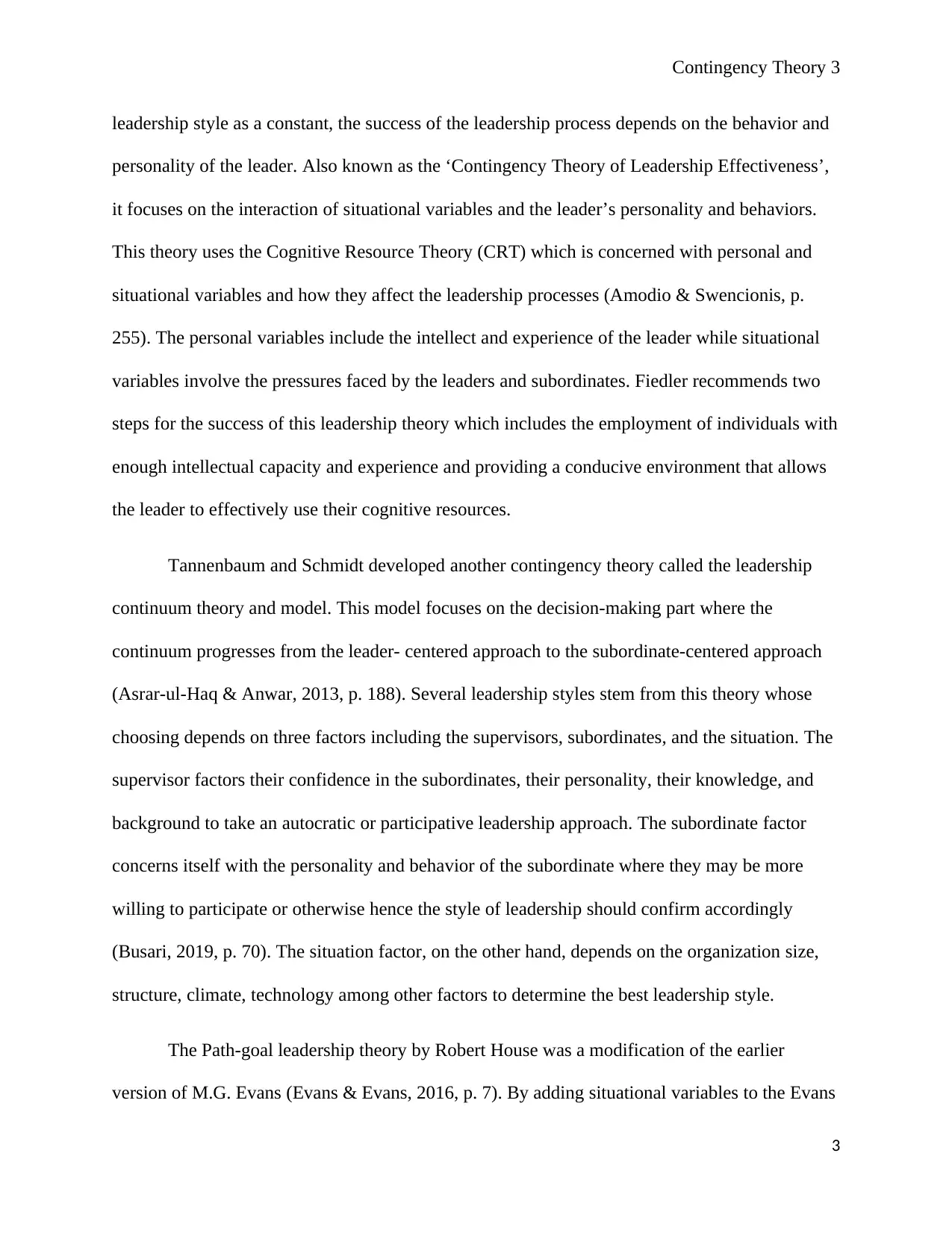
Contingency Theory 3
leadership style as a constant, the success of the leadership process depends on the behavior and
personality of the leader. Also known as the ‘Contingency Theory of Leadership Effectiveness’,
it focuses on the interaction of situational variables and the leader’s personality and behaviors.
This theory uses the Cognitive Resource Theory (CRT) which is concerned with personal and
situational variables and how they affect the leadership processes (Amodio & Swencionis, p.
255). The personal variables include the intellect and experience of the leader while situational
variables involve the pressures faced by the leaders and subordinates. Fiedler recommends two
steps for the success of this leadership theory which includes the employment of individuals with
enough intellectual capacity and experience and providing a conducive environment that allows
the leader to effectively use their cognitive resources.
Tannenbaum and Schmidt developed another contingency theory called the leadership
continuum theory and model. This model focuses on the decision-making part where the
continuum progresses from the leader- centered approach to the subordinate-centered approach
(Asrar-ul-Haq & Anwar, 2013, p. 188). Several leadership styles stem from this theory whose
choosing depends on three factors including the supervisors, subordinates, and the situation. The
supervisor factors their confidence in the subordinates, their personality, their knowledge, and
background to take an autocratic or participative leadership approach. The subordinate factor
concerns itself with the personality and behavior of the subordinate where they may be more
willing to participate or otherwise hence the style of leadership should confirm accordingly
(Busari, 2019, p. 70). The situation factor, on the other hand, depends on the organization size,
structure, climate, technology among other factors to determine the best leadership style.
The Path-goal leadership theory by Robert House was a modification of the earlier
version of M.G. Evans (Evans & Evans, 2016, p. 7). By adding situational variables to the Evans
3
leadership style as a constant, the success of the leadership process depends on the behavior and
personality of the leader. Also known as the ‘Contingency Theory of Leadership Effectiveness’,
it focuses on the interaction of situational variables and the leader’s personality and behaviors.
This theory uses the Cognitive Resource Theory (CRT) which is concerned with personal and
situational variables and how they affect the leadership processes (Amodio & Swencionis, p.
255). The personal variables include the intellect and experience of the leader while situational
variables involve the pressures faced by the leaders and subordinates. Fiedler recommends two
steps for the success of this leadership theory which includes the employment of individuals with
enough intellectual capacity and experience and providing a conducive environment that allows
the leader to effectively use their cognitive resources.
Tannenbaum and Schmidt developed another contingency theory called the leadership
continuum theory and model. This model focuses on the decision-making part where the
continuum progresses from the leader- centered approach to the subordinate-centered approach
(Asrar-ul-Haq & Anwar, 2013, p. 188). Several leadership styles stem from this theory whose
choosing depends on three factors including the supervisors, subordinates, and the situation. The
supervisor factors their confidence in the subordinates, their personality, their knowledge, and
background to take an autocratic or participative leadership approach. The subordinate factor
concerns itself with the personality and behavior of the subordinate where they may be more
willing to participate or otherwise hence the style of leadership should confirm accordingly
(Busari, 2019, p. 70). The situation factor, on the other hand, depends on the organization size,
structure, climate, technology among other factors to determine the best leadership style.
The Path-goal leadership theory by Robert House was a modification of the earlier
version of M.G. Evans (Evans & Evans, 2016, p. 7). By adding situational variables to the Evans
3
⊘ This is a preview!⊘
Do you want full access?
Subscribe today to unlock all pages.

Trusted by 1+ million students worldwide
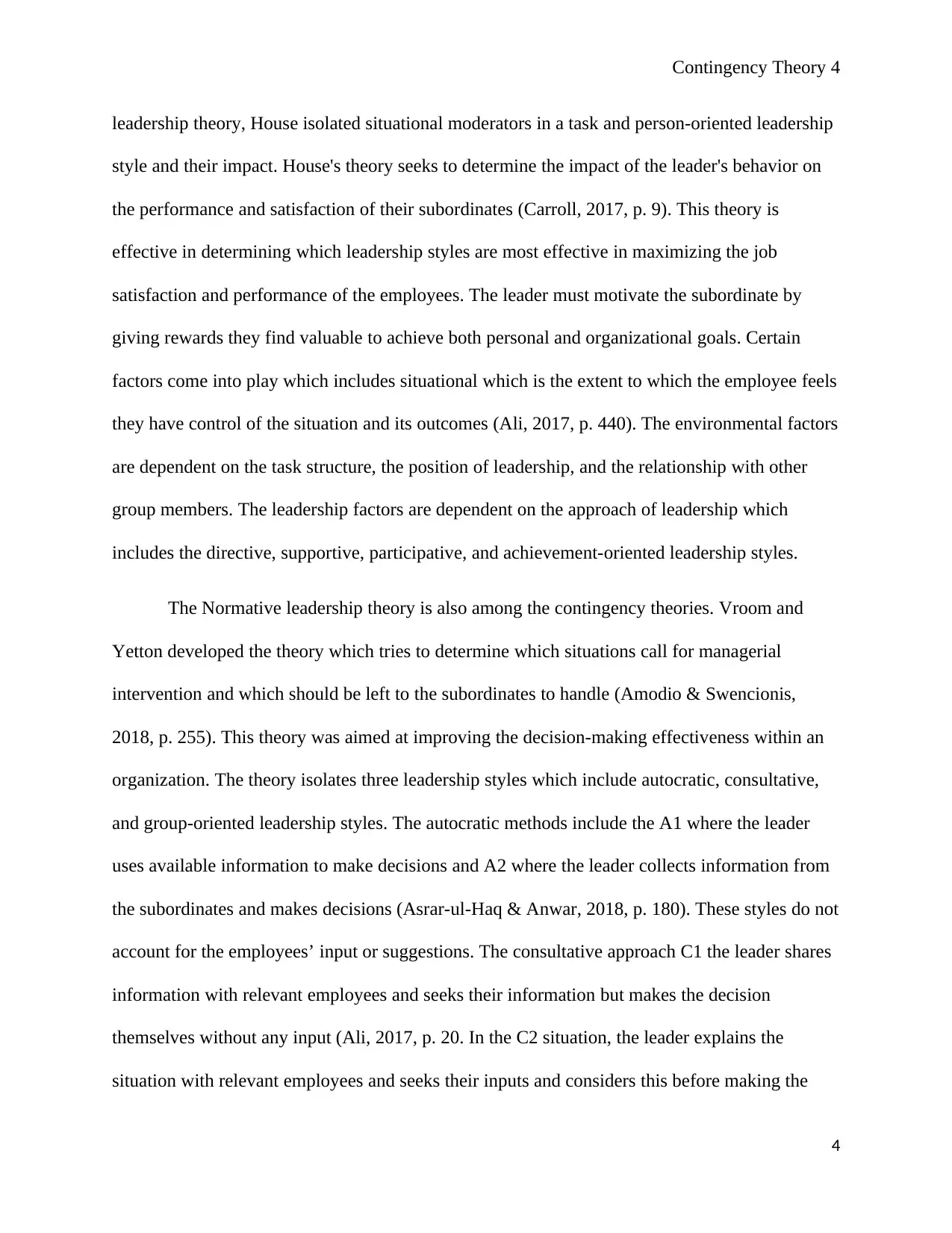
Contingency Theory 4
leadership theory, House isolated situational moderators in a task and person-oriented leadership
style and their impact. House's theory seeks to determine the impact of the leader's behavior on
the performance and satisfaction of their subordinates (Carroll, 2017, p. 9). This theory is
effective in determining which leadership styles are most effective in maximizing the job
satisfaction and performance of the employees. The leader must motivate the subordinate by
giving rewards they find valuable to achieve both personal and organizational goals. Certain
factors come into play which includes situational which is the extent to which the employee feels
they have control of the situation and its outcomes (Ali, 2017, p. 440). The environmental factors
are dependent on the task structure, the position of leadership, and the relationship with other
group members. The leadership factors are dependent on the approach of leadership which
includes the directive, supportive, participative, and achievement-oriented leadership styles.
The Normative leadership theory is also among the contingency theories. Vroom and
Yetton developed the theory which tries to determine which situations call for managerial
intervention and which should be left to the subordinates to handle (Amodio & Swencionis,
2018, p. 255). This theory was aimed at improving the decision-making effectiveness within an
organization. The theory isolates three leadership styles which include autocratic, consultative,
and group-oriented leadership styles. The autocratic methods include the A1 where the leader
uses available information to make decisions and A2 where the leader collects information from
the subordinates and makes decisions (Asrar-ul-Haq & Anwar, 2018, p. 180). These styles do not
account for the employees’ input or suggestions. The consultative approach C1 the leader shares
information with relevant employees and seeks their information but makes the decision
themselves without any input (Ali, 2017, p. 20. In the C2 situation, the leader explains the
situation with relevant employees and seeks their inputs and considers this before making the
4
leadership theory, House isolated situational moderators in a task and person-oriented leadership
style and their impact. House's theory seeks to determine the impact of the leader's behavior on
the performance and satisfaction of their subordinates (Carroll, 2017, p. 9). This theory is
effective in determining which leadership styles are most effective in maximizing the job
satisfaction and performance of the employees. The leader must motivate the subordinate by
giving rewards they find valuable to achieve both personal and organizational goals. Certain
factors come into play which includes situational which is the extent to which the employee feels
they have control of the situation and its outcomes (Ali, 2017, p. 440). The environmental factors
are dependent on the task structure, the position of leadership, and the relationship with other
group members. The leadership factors are dependent on the approach of leadership which
includes the directive, supportive, participative, and achievement-oriented leadership styles.
The Normative leadership theory is also among the contingency theories. Vroom and
Yetton developed the theory which tries to determine which situations call for managerial
intervention and which should be left to the subordinates to handle (Amodio & Swencionis,
2018, p. 255). This theory was aimed at improving the decision-making effectiveness within an
organization. The theory isolates three leadership styles which include autocratic, consultative,
and group-oriented leadership styles. The autocratic methods include the A1 where the leader
uses available information to make decisions and A2 where the leader collects information from
the subordinates and makes decisions (Asrar-ul-Haq & Anwar, 2018, p. 180). These styles do not
account for the employees’ input or suggestions. The consultative approach C1 the leader shares
information with relevant employees and seeks their information but makes the decision
themselves without any input (Ali, 2017, p. 20. In the C2 situation, the leader explains the
situation with relevant employees and seeks their inputs and considers this before making the
4
Paraphrase This Document
Need a fresh take? Get an instant paraphrase of this document with our AI Paraphraser
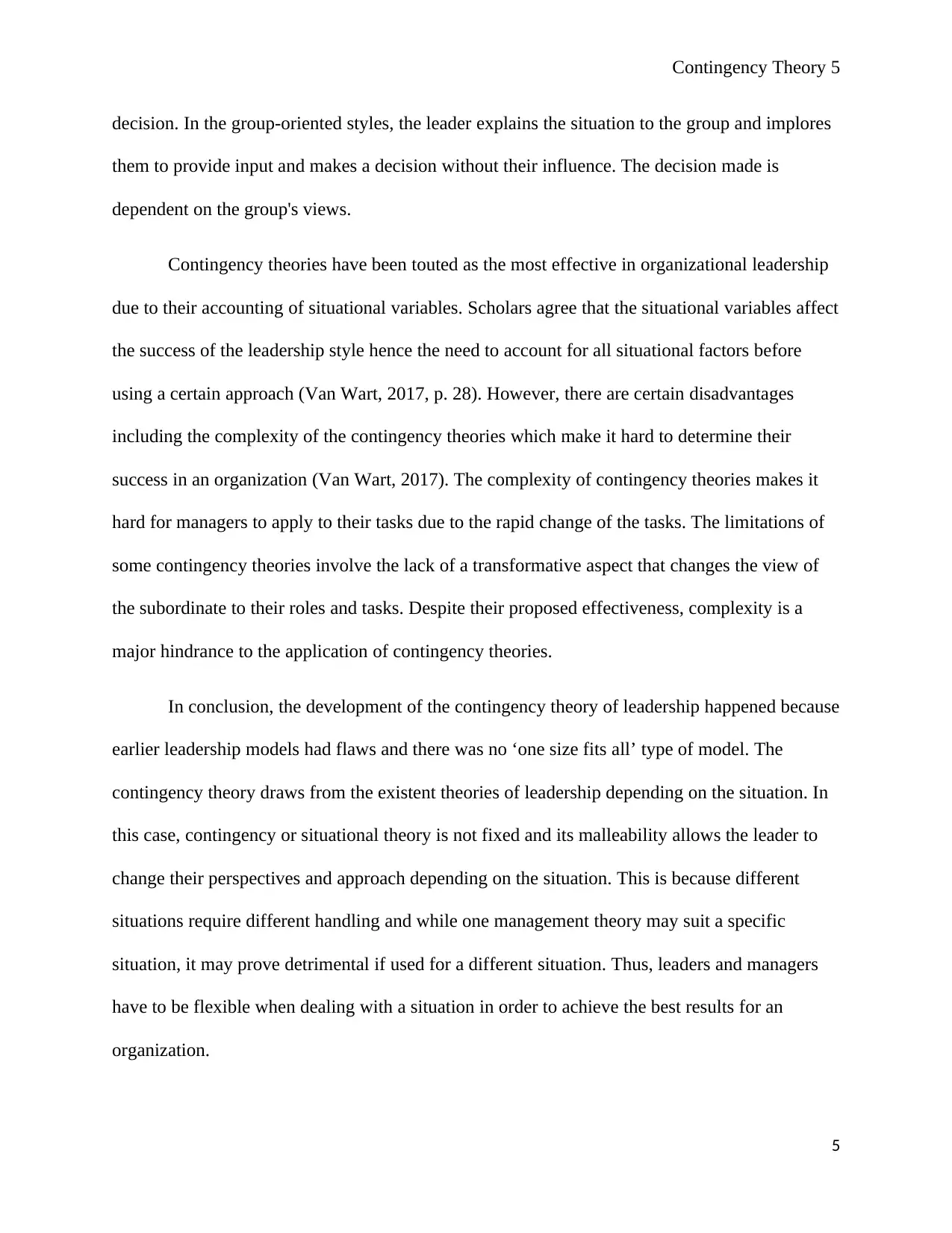
Contingency Theory 5
decision. In the group-oriented styles, the leader explains the situation to the group and implores
them to provide input and makes a decision without their influence. The decision made is
dependent on the group's views.
Contingency theories have been touted as the most effective in organizational leadership
due to their accounting of situational variables. Scholars agree that the situational variables affect
the success of the leadership style hence the need to account for all situational factors before
using a certain approach (Van Wart, 2017, p. 28). However, there are certain disadvantages
including the complexity of the contingency theories which make it hard to determine their
success in an organization (Van Wart, 2017). The complexity of contingency theories makes it
hard for managers to apply to their tasks due to the rapid change of the tasks. The limitations of
some contingency theories involve the lack of a transformative aspect that changes the view of
the subordinate to their roles and tasks. Despite their proposed effectiveness, complexity is a
major hindrance to the application of contingency theories.
In conclusion, the development of the contingency theory of leadership happened because
earlier leadership models had flaws and there was no ‘one size fits all’ type of model. The
contingency theory draws from the existent theories of leadership depending on the situation. In
this case, contingency or situational theory is not fixed and its malleability allows the leader to
change their perspectives and approach depending on the situation. This is because different
situations require different handling and while one management theory may suit a specific
situation, it may prove detrimental if used for a different situation. Thus, leaders and managers
have to be flexible when dealing with a situation in order to achieve the best results for an
organization.
5
decision. In the group-oriented styles, the leader explains the situation to the group and implores
them to provide input and makes a decision without their influence. The decision made is
dependent on the group's views.
Contingency theories have been touted as the most effective in organizational leadership
due to their accounting of situational variables. Scholars agree that the situational variables affect
the success of the leadership style hence the need to account for all situational factors before
using a certain approach (Van Wart, 2017, p. 28). However, there are certain disadvantages
including the complexity of the contingency theories which make it hard to determine their
success in an organization (Van Wart, 2017). The complexity of contingency theories makes it
hard for managers to apply to their tasks due to the rapid change of the tasks. The limitations of
some contingency theories involve the lack of a transformative aspect that changes the view of
the subordinate to their roles and tasks. Despite their proposed effectiveness, complexity is a
major hindrance to the application of contingency theories.
In conclusion, the development of the contingency theory of leadership happened because
earlier leadership models had flaws and there was no ‘one size fits all’ type of model. The
contingency theory draws from the existent theories of leadership depending on the situation. In
this case, contingency or situational theory is not fixed and its malleability allows the leader to
change their perspectives and approach depending on the situation. This is because different
situations require different handling and while one management theory may suit a specific
situation, it may prove detrimental if used for a different situation. Thus, leaders and managers
have to be flexible when dealing with a situation in order to achieve the best results for an
organization.
5
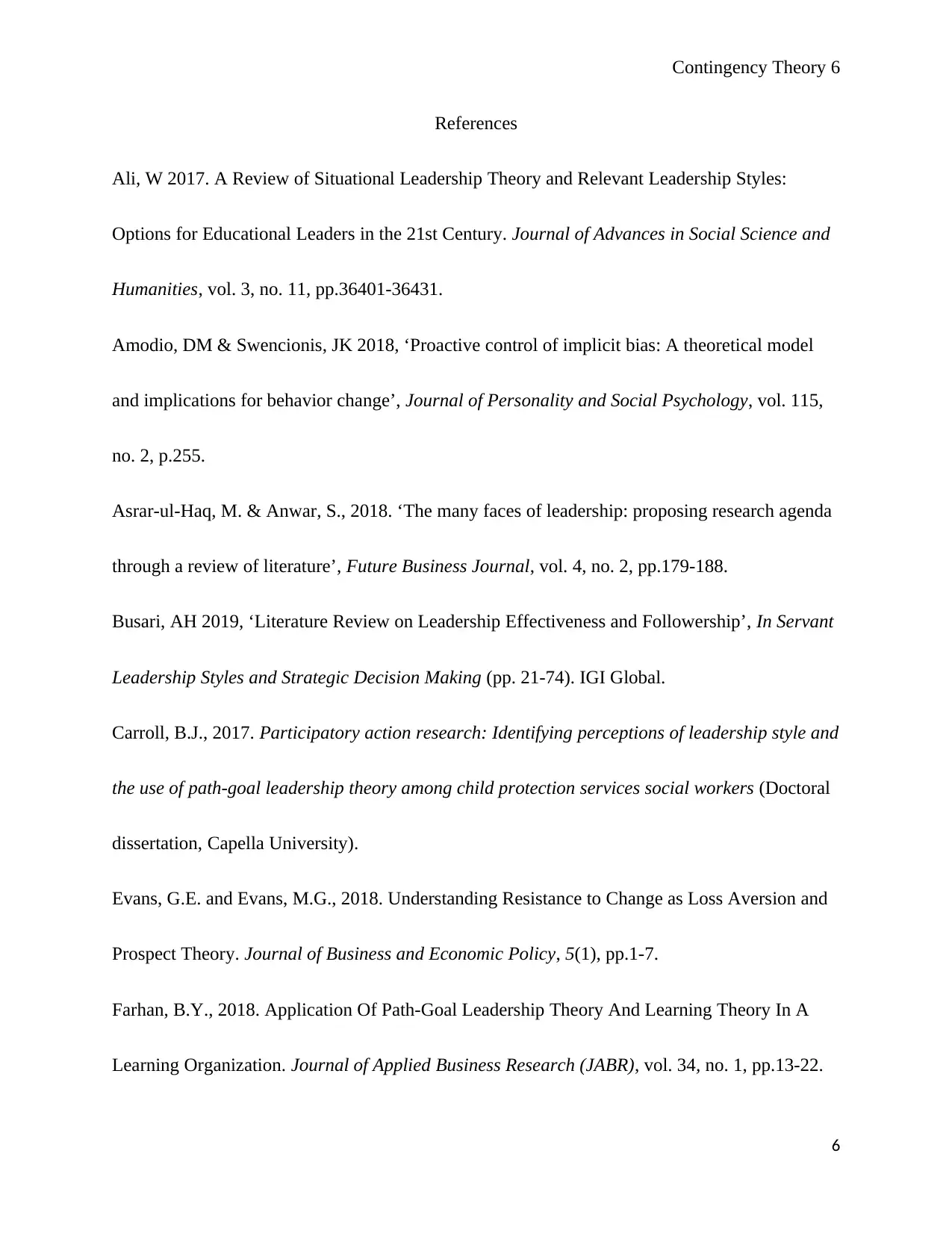
Contingency Theory 6
References
Ali, W 2017. A Review of Situational Leadership Theory and Relevant Leadership Styles:
Options for Educational Leaders in the 21st Century. Journal of Advances in Social Science and
Humanities, vol. 3, no. 11, pp.36401-36431.
Amodio, DM & Swencionis, JK 2018, ‘Proactive control of implicit bias: A theoretical model
and implications for behavior change’, Journal of Personality and Social Psychology, vol. 115,
no. 2, p.255.
Asrar-ul-Haq, M. & Anwar, S., 2018. ‘The many faces of leadership: proposing research agenda
through a review of literature’, Future Business Journal, vol. 4, no. 2, pp.179-188.
Busari, AH 2019, ‘Literature Review on Leadership Effectiveness and Followership’, In Servant
Leadership Styles and Strategic Decision Making (pp. 21-74). IGI Global.
Carroll, B.J., 2017. Participatory action research: Identifying perceptions of leadership style and
the use of path-goal leadership theory among child protection services social workers (Doctoral
dissertation, Capella University).
Evans, G.E. and Evans, M.G., 2018. Understanding Resistance to Change as Loss Aversion and
Prospect Theory. Journal of Business and Economic Policy, 5(1), pp.1-7.
Farhan, B.Y., 2018. Application Of Path-Goal Leadership Theory And Learning Theory In A
Learning Organization. Journal of Applied Business Research (JABR), vol. 34, no. 1, pp.13-22.
6
References
Ali, W 2017. A Review of Situational Leadership Theory and Relevant Leadership Styles:
Options for Educational Leaders in the 21st Century. Journal of Advances in Social Science and
Humanities, vol. 3, no. 11, pp.36401-36431.
Amodio, DM & Swencionis, JK 2018, ‘Proactive control of implicit bias: A theoretical model
and implications for behavior change’, Journal of Personality and Social Psychology, vol. 115,
no. 2, p.255.
Asrar-ul-Haq, M. & Anwar, S., 2018. ‘The many faces of leadership: proposing research agenda
through a review of literature’, Future Business Journal, vol. 4, no. 2, pp.179-188.
Busari, AH 2019, ‘Literature Review on Leadership Effectiveness and Followership’, In Servant
Leadership Styles and Strategic Decision Making (pp. 21-74). IGI Global.
Carroll, B.J., 2017. Participatory action research: Identifying perceptions of leadership style and
the use of path-goal leadership theory among child protection services social workers (Doctoral
dissertation, Capella University).
Evans, G.E. and Evans, M.G., 2018. Understanding Resistance to Change as Loss Aversion and
Prospect Theory. Journal of Business and Economic Policy, 5(1), pp.1-7.
Farhan, B.Y., 2018. Application Of Path-Goal Leadership Theory And Learning Theory In A
Learning Organization. Journal of Applied Business Research (JABR), vol. 34, no. 1, pp.13-22.
6
⊘ This is a preview!⊘
Do you want full access?
Subscribe today to unlock all pages.

Trusted by 1+ million students worldwide
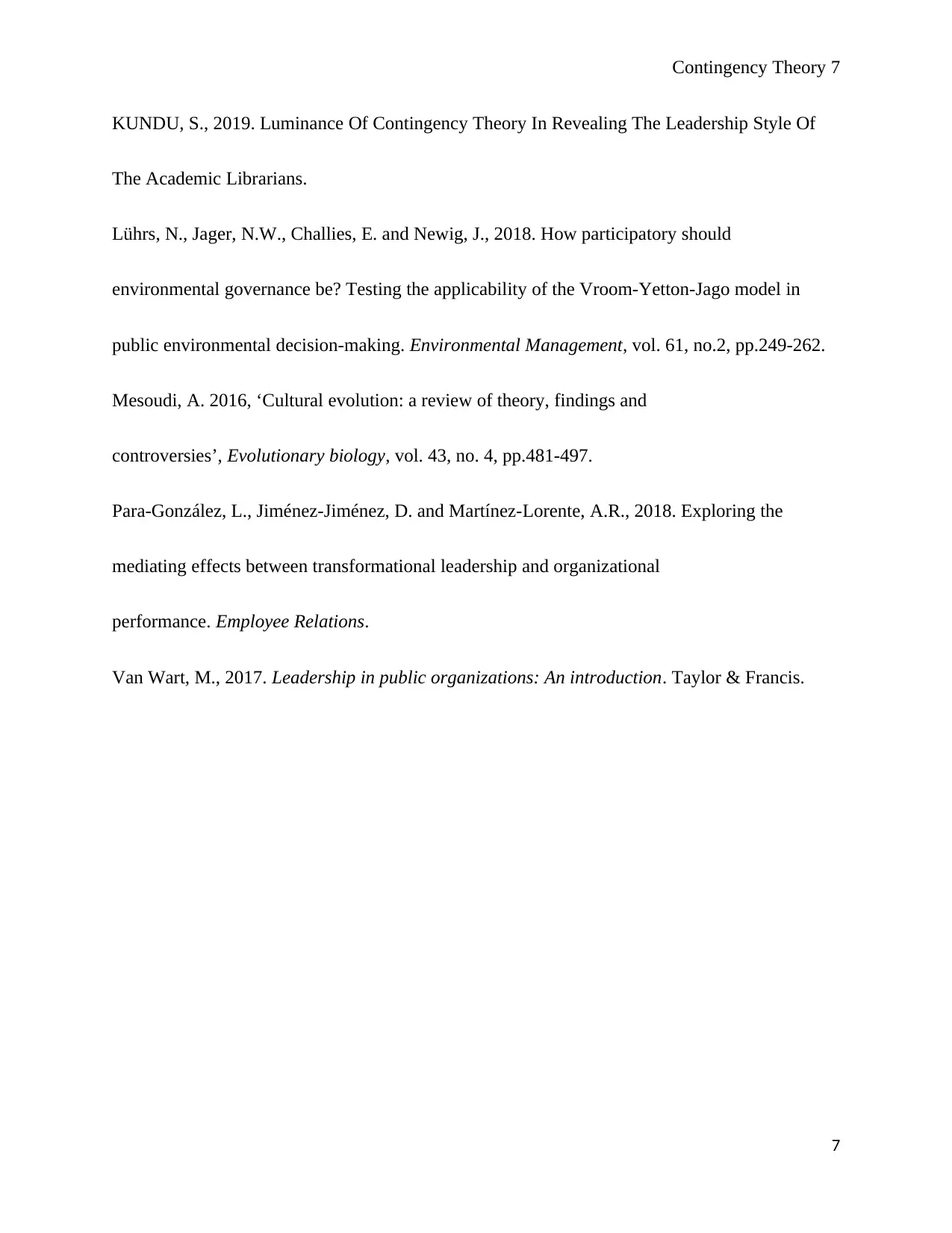
Contingency Theory 7
KUNDU, S., 2019. Luminance Of Contingency Theory In Revealing The Leadership Style Of
The Academic Librarians.
Lührs, N., Jager, N.W., Challies, E. and Newig, J., 2018. How participatory should
environmental governance be? Testing the applicability of the Vroom-Yetton-Jago model in
public environmental decision-making. Environmental Management, vol. 61, no.2, pp.249-262.
Mesoudi, A. 2016, ‘Cultural evolution: a review of theory, findings and
controversies’, Evolutionary biology, vol. 43, no. 4, pp.481-497.
Para-González, L., Jiménez-Jiménez, D. and Martínez-Lorente, A.R., 2018. Exploring the
mediating effects between transformational leadership and organizational
performance. Employee Relations.
Van Wart, M., 2017. Leadership in public organizations: An introduction. Taylor & Francis.
7
KUNDU, S., 2019. Luminance Of Contingency Theory In Revealing The Leadership Style Of
The Academic Librarians.
Lührs, N., Jager, N.W., Challies, E. and Newig, J., 2018. How participatory should
environmental governance be? Testing the applicability of the Vroom-Yetton-Jago model in
public environmental decision-making. Environmental Management, vol. 61, no.2, pp.249-262.
Mesoudi, A. 2016, ‘Cultural evolution: a review of theory, findings and
controversies’, Evolutionary biology, vol. 43, no. 4, pp.481-497.
Para-González, L., Jiménez-Jiménez, D. and Martínez-Lorente, A.R., 2018. Exploring the
mediating effects between transformational leadership and organizational
performance. Employee Relations.
Van Wart, M., 2017. Leadership in public organizations: An introduction. Taylor & Francis.
7
1 out of 7
Related Documents
Your All-in-One AI-Powered Toolkit for Academic Success.
+13062052269
info@desklib.com
Available 24*7 on WhatsApp / Email
![[object Object]](/_next/static/media/star-bottom.7253800d.svg)
Unlock your academic potential
Copyright © 2020–2025 A2Z Services. All Rights Reserved. Developed and managed by ZUCOL.





